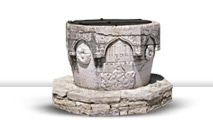
- Sečovlje Salt Pans - Dragonja River Valley
- Sv. Peter - Nova vas - Padna
- Pomjan - Nature Park: Karst Edge - Socerb
- Črni Kal - Osp - Kubed
- Momjan - Grožnjan - Pietrapelosa - Mirna
- Baštija - Kostanjica - Parenzana
- Oprtalj - Završje - Livade - Zrenj
- Istarske toplice - Motovun Forest - Višnjan
- Cave Mramornica - Feštini Kingdom - Cave Baredine
- Lim Bay - Kloštar - Kontija - Dvigrad
- Kanfanar - Bale - Palud - Vodnjan -Islands Brijuni - Fažana
- Svetvinčenat - Tinjan - Pićan - Gračišće
- Belaj - Šumber - Kožljak - Paz
- Čepićko Field - Kršan - Boljun Castle - Lupoglav
- Plomin - Kvarner Gulf - Brseč
- Nature park Učka - Mošćenice
Svetvinčenat - Tinjan - Pićan - Gračišće
Svetvinčenat
Set amidst large areas of oak forests, on a plateau surrounded by Barban, Žminj, Dvigrad, Bale and Vodnjan, the very beginnings of this town are connected with Benedictine monks from Ravenna, who in the 6th c. settled this area rich in wood.
The town has several names – Svetvinčenat, Savičenta, San Vincenti, all derived from the name of the patron saint and martyr St. Vincent and abbey of the same name around...
More

Pićan
Owing to its strategically important location, it was the site of a prehistoric hill-fort, and in Roman times Pićan was a military stronghold. From the 6th - 18th cc. it was the seat of the only diocese in the interior of Istria with 12 parishes, and due to such a connection with the Roman Church it always had a significant place and great power in Central Istria.
At the time of Byzantine rule Pićan was the...
More

Tinjan
The local history dates from about 1500 BC, which is testified by the grave on Sv. Špete hill. In the Roman times the road connecting Poreč and Pazin passed here. Most probably the area of Tinjan was given as a reward to a Roman soldier, whereas its present-day name is of Slavic origin.
In the Middle Ages its destiny was defined by - marriage, which, together with the Castle of Pazin, brought it into...
More

Gračišće
Although the area was settled even before the golden age of the Roman Empire, the present-day name of Gračišće is of Slavic origin dating from the 6th and 7th cc. at the time of the settling of the Slavs. Its spiritual heritage can be discerned in the name of Perunčevac Hill, named after Perun, the highest Slavic god, but also in the thousand-year-old worshipping of Svantovid, the origin, some people believe, of the...
More
 Print page Send to a friend
Print page Send to a friend















